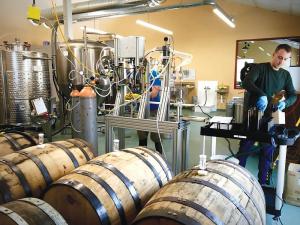2023 - Volume #47, Issue #5, Page #09
[ Sample Stories From This Issue | List of All Stories In This Issue | Print this story
| Read this issue]
They Make Cider From Wild Apples
 |
“With wild apples, every cider comes out tasting a little different,” says Matt Raboin.
Making cider started as a hobby for the Raboins while they were dating in 2008. They’ve been producing cider commercially since 2016 and opened their own cidery with a farm-to-table restaurant in 2019.
“There are a lot of small orchards in Wisconsin, and we’ve sourced apples from a bunch of them,” says Raboin. “We pick a lot ourselves and also buy prepicked. We know the people we buy from and are supporting local orchards, sometimes making custom ciders for them to sell at their own orchard.”
When Raboin talks about wild apples, he may be describing trees of a forgotten variety remaining in an abandoned farm orchard. It’s also possible that he’s talking about one grown from seed.
“Any tree that comes up from seed will be different,” says Raboin. “Many farms used to have a small orchard, perhaps 20 trees. Apple seed would be dispersed by cows and other animals.”
The idea of using apples from these orchard escapes came when his wife was traveling back roads and remote fields working for the Natural Resource and Conservation Service.
“She’d see apple trees on a back pasture, and we thought we might be able to do something with them,” says Raboin. “We started picking them with permission, and it became a kind of adventure. We’d drive out in the field, park, and pull out our ladders.”
Results depend on the year, as one year they’ll do poorly, and another produces a ton of apples. Bugs and disease also eliminate many wild apples from ciders. Taste, of course, is the key factor.
“We’ll taste an apple or two, which can be tricky as they may not be ripe at the time, so we skip that tree,” says Raboin. “It’s not efficient like picking in an orchard, where you know all the trees of a variety are ripe.”
Even one that doesn’t taste great as a fresh-eating apple may have the potential for cider. Astringency can be a sought-after component in a blend, while a very sweet apple by itself, may produce a bland and relatively tasteless cider. It often becomes a base for other fruits such as cherry or elderberry.
“When we find an apple that’s really good, we pick as much as we can,” says Raboin. “If it’s exceptional, we flag it and come back in the winter to collect scion wood for grafting in our orchard.”
Once the Raboins get their apples home to the Brix Cider brewhouse, wild apples may be treated differently. Yeast is a common ingredient for starting fermentation, but not necessarily so with wild apples.
“We often let them spontaneously ferment with the spores naturally on them or in the air around them,” says Raboin.
If the resulting cider is good enough, it may be blended with other ciders or be bottled with its own label and name. The end result is seldom a surprise he says.
“After tasting lots of apples and making lots of ciders, you get a sense of what comes through in the cider,” says Raboin.
Contact: FARM SHOW Followup, Brix Cider, 119 S 2nd St., Mount Horeb, Wis. 53572 (ph 608-437-2749; matt@brixcider.com; www.brixcider.com).

Click here to download page story appeared in.

Click here to read entire issue
To read the rest of this story, download this issue below or click here to register with your account number.




